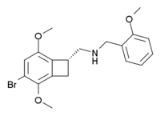
2CBCB-NBOMe
Encyclopedia
2CBCB-NBOMe is a compound indirectly derived from the phenethylamine
series of hallucinogens, which was discovered in 2007 at Purdue University
as part of the ongoing research program of the team led by David Nichols focusing on the mapping of the specific amino acid residues responsible for ligand binding to the 5HT2A receptor
. 2CBCB-NBOMe acts as a potent and selective agonist
for the 5-HT2A and 5-HT2C receptors, with a Ki of 0.27nM at the human 5-HT2A receptor, a similar potency to other agonists such as TCB-2
, NBOMe-2C-I and bromodragonfly
Phenethylamine
Phenylethylamine or phenethylamine is a natural monoamine alkaloid, trace amine, and also the name of a class of chemicals with many members well known for psychoactive drug and stimulant effects. Studies suggest that phenylethylamine functions as a neuromodulator or neurotransmitter in the...
series of hallucinogens, which was discovered in 2007 at Purdue University
Purdue University
Purdue University, located in West Lafayette, Indiana, U.S., is the flagship university of the six-campus Purdue University system. Purdue was founded on May 6, 1869, as a land-grant university when the Indiana General Assembly, taking advantage of the Morrill Act, accepted a donation of land and...
as part of the ongoing research program of the team led by David Nichols focusing on the mapping of the specific amino acid residues responsible for ligand binding to the 5HT2A receptor
Receptor (biochemistry)
In biochemistry, a receptor is a molecule found on the surface of a cell, which receives specific chemical signals from neighbouring cells or the wider environment within an organism...
. 2CBCB-NBOMe acts as a potent and selective agonist
Agonist
An agonist is a chemical that binds to a receptor of a cell and triggers a response by that cell. Agonists often mimic the action of a naturally occurring substance...
for the 5-HT2A and 5-HT2C receptors, with a Ki of 0.27nM at the human 5-HT2A receptor, a similar potency to other agonists such as TCB-2
TCB-2
TCB-2 is a hallucinogen, discovered in 2006 by a team at Purdue University where it has been named 2C-BCB. It is a conformationally-restricted derivative of the phenethylamine 2C-B, also a hallucinogen, and acts as a potent agonist for the 5-HT2A and 5-HT2C receptors with a Ki of 0.26nM at the...
, NBOMe-2C-I and bromodragonfly
See also
- 2CBFly-NBOMe2CBFly-NBOMe2CBFly-NBOMe is a compound indirectly derived from the phenethylamine hallucinogen 2C-B, and related to benzodifurans like 2C-B-FLY and N-benzylphenethylamines like NBOMe-2C-I...
(NBOMe-2CB-Fly) - 2C-C-NBOMe2C-C-NBOMe2C-C-NBOMe is a derivative of the phenethylamine hallucinogen 2C-C, which acts as a potent partial agonist for the 5HT2A receptor, and has been studied in its 11C radiolabelled form as a potential ligand for mapping the distribution of 5-HT2A receptors in the brain, using positron emission...
(NBOMe-2CC) - 25B-NBOMe25B-NBOMe25B-NBOMe is a derivative of the phenethylamine hallucinogen 2C-B, discovered in 2004 by Ralf Heim at the Free University of Berlin. It acts as a potent partial agonist for the 5HT2A receptor...
(NBOMe-2CB) - 25I-NBMD25I-NBMD25I-NBMD is a derivative of the phenethylamine hallucinogen 2C-I, discovered in 2006 by a team at Purdue University led by David Nichols. It acts as a potent partial agonist for the 5HT2A receptor with a Ki of 0.049nM at the human 5HT2A receptor...
(NBMD-2CI) - 25I-NBOH25I-NBOH25I-NBOH is a derivative of the phenethylamine derived hallucinogen 2C-I, discovered in 2006 by a team at Purdue University. It acts as a potent agonist for the 5HT2A receptor, with a Ki of 0.12nM at the human 5HT2A receptor, making it some 5x the potency of 2C-I itself...
(NBOH-2CI) - 25I-NBOMe25I-NBOMe25I-NBOMe is a derivative of the phenethylamine hallucinogen 2C-I, discovered in 2003 by Ralf Heim at the Free University of Berlin, and subsequently investigated in more detail by a team at Purdue University led by David Nichols.25I-NBOMe acts as a highly potent agonist for the human 5-HT2A...
(NBOMe-2CI) - 2C-TFM-NBOMe2C-TFM-NBOMe2C-TFM-NBOMe is a derivative of the phenethylamine hallucinogen 2C-TFM, discovered in 2004 by Ralf Heim at the Free University of Berlin...
(NBOMe-2C-TFM) - 25I-NBF25I-NBF25I-NBF is a derivative of the phenethylamine hallucinogen 2C-I, which acts as a highly potent partial agonist for the human 5-HT2A receptor...
(NBF-2CI)

